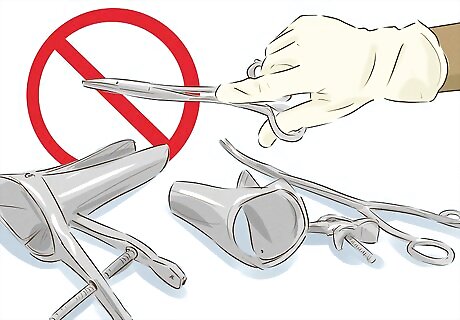
views
Finding an Abortion Provider

Look for an abortion provider in your area. You may already know of a place where someone you know has had an abortion, like a local health clinic that provides abortion as well as birth control and other reproductive health services. If you don't know of a provider and don't feel comfortable asking around, look online at Planned Parenthood's website for a list of providers near you. Just enter your zip code and a list of options will come up. If you trust your family doctor, you can ask for a referral. Your doctor may be able to give you contact information for a provider, either in a local hospital or at a health clinic. However, not all are willing to give referrals. Be wary of advertisements for providers or clinics online. Sometimes doctors you find in this way are not licensed to provide abortions. Stick with providers you've heard of before or those referred by someone you know and trust.

Call the facility and ask about their services. Ask up front if they actually perform abortions there, since some health centers just give referrals. It might help to write down a list of other questions you want to ask before making your appointment, like how many times you'll need to visit before you can get an abortion, whether you can bring a friend with you, and what information you'll need to provide. You might want to check out the clinic to make sure you’re comfortable there. Licensed facilities are clean, well-maintained and professional. If something makes you feel uncomfortable, see if there's a better option. Never get an abortion in someone’s house or in an illegal clinic. If you're not sure whether the place is legitimate, ask for the abortion provider's name and confirm that they are a board-certified obstetrician.

Ask about pricing. For a first trimester abortion, pricing usually ranges from $300 to $1,000. Prices vary depending on how long you've been pregnant. A late-term abortion can be more expensive, since it involves a different type of procedure. Hospitals generally charge more than health clinics. If you're worried about how to pay for an abortion, there are usually options available to help cover the cost. Some clinics have a sliding scale or payment plans available so you don't have to pay the entire cost at once. Sometimes health insurance can cover it, though in most cases insurance covers birth control but not abortion. Check with your insurance company to find out more. If you're not insured, another option is to get help from an abortion fund. An abortion fund is a group of people who care about reproductive rights and help people who can't afford abortions to cover the cost of the procedure.

Find a provider in states where it’s difficult. Some states have passed so many strict laws regarding abortion that many clinics have shut down. This can make it hard to find a place to get an abortion, especially if you don't have a car to drive to the nearest city with a clinic. If you’re in a city without an abortion provider, you still have options. Figure out where the closest clinic is. Check out major cities, even if they aren't in the same state you live in. See if you can arrange transportation and stay with a friend or family member there. You'll have to do a little extra planning, since most providers require that you come in at least two times: once for the initial consultation and again for the abortion. See if there’s a program designed to help people in your situation. Call the clinic where you want to have the procedure and tell them your situation. Nonprofit reproductive rights groups often provide transportation and housing to people who need to travel from out of town.

Familiarize yourself with state laws. Different states have different requirements regarding when, where and how an abortion can be performed. For example, some states have passed a law stating that abortions must be performed in a hospital, while others allow it to be performed in a separate medical facility. Learning about the status of abortion in your state will help you navigate the process more easily. If you have questions, call up a local abortion provider to discuss your situation and find out if there are any specific requirements you need to know about. Each state has its own requirements regarding parental consent. If you're under 18, your state might require that you get your parents' permission to have an abortion. If you're uncomfortable with this, you can ask a judge to give you a "judicial bypass," or waive the requirement so you can get an abortion without asking your parents. In some states you might be required to get pre-abortion counseling, get an ultrasound, or wait a certain amount of time between your first consultation and the abortion appointment. In some states it is illegal to get an abortion after six months of pregnancy. After that point, you need to go to another state and possibly acquire an out-of-state judicial bypass.

Never try it yourself. The process of getting an abortion, from finding a provider to discussing your options with a counselor to going through the procedure and paying for it, can be intimidating. Some people are tempted to try to end the pregnancy on their own so they don't have to tell anyone else they're pregnant. This is an extremely dangerous thing to do, and should not be considered under any circumstances. Self-abortions often lead to severe injury and death. They are most common in places where abortion is illegal. Legal abortions are one of the most common procedures done in the US, and are extremely safe when performed in a clean facility by a licensed provider. More than one-third of adult cisgender women are estimated to have had at least one abortion.
Knowing What to Expect

Make an initial appointment with your chosen provider. When you call the provider you've chosen, you'll schedule an appointment to take place in the next few days. On the day of the appointment, you'll talk with a counselor, take a pregnancy test and discuss the different options available to you. You will be asked to fill out some paperwork regarding your medical history. Make sure to answer the questions honestly so that you'll receive the right kind of care. Remember that you can change your mind at any time. If your discussion with the counselor leaves you feeling you'd rather not have an abortion, you can absolutely decide against it.

Decide what type of abortion to have. The available options will be different depending on how long you've been pregnant. Your counselor will help you figure out which one is right for your situation. Each type of procedure is safe and effective. Aspiration is the most common type of abortion procedure, and is usually available through the first 16 weeks of pregnancy. You'll receive an examination and light sedation that allows you to stay awake the whole time. A tube is inserted into the cervix, and a suction device is used to remove the fetus. It takes no more than 10 minutes. Dilation and evacuation (D&E) is similar to aspiration, but it's performed after the first 16 weeks of pregnancy. Medication is administered to dilate the cervix, and a suction device is used to remove the fetus. The procedure takes 10 to 20 minutes, not counting the time it takes to prepare the cervix. The abortion pill is another option you can choose for a first trimester abortion. In a chemical abortion, you're giving two types of medication to take: one that encourages the lining of the uterus to break down, and one that causes it to empty (misoprostol). It causes cramps and bleeding, and a follow-up appointment is recommended.

Make plans for the day of the procedure. Plan to get there a few minutes early so the appointment doesn't run behind. The total time you'll spend at the facility can be anywhere from two to four hours, depending on how long you have to wait. In most cases you'll receive an ultrasound and an examination before the actual abortion takes place, and you'll spend an hour or so recovering before it's time to leave. You might want to bring a friend to stay with you at the facility and drive you home afterward. Follow the instructions you were given at your first appointment regarding how to physically prepare for the abortion. You should not eat or drink during the two hours prior to the abortion, and you should not use alcohol after midnight the night before. You might feel low energy for the rest of the day after you have the abortion. Plan to take it easy on the day of your appointment and for the next few days. You might want to arrange to take a day off of work, or schedule the procedure for a weekend so you have time to rest.

Follow instructions for aftercare. You'll be given a packet of instructions on how to care for yourself after the abortion. You'll experience light to moderate bleeding and light cramping, which should subside within a few hours. You'll be instructed to get medical attention immediately if bleeding persists. Follow your doctor or clinic's instructions for when you can have sex again, but you can take a shower as soon as you want to. Go in for follow-up appointment if you were instructed to do so.
Getting Support

Talk with people you trust when you’re weighing your decision. When you're deciding whether to have an abortion, it's important to get support as you weigh your options. Having people you trust to talk to about your feelings after the procedure is also really helpful. No matter what, realize you aren't alone in this. Talk to friends or family members who have been through it before. Seek support if you can’t talk to your family. Contact a counselor at your school or at a health facility staffed with people who understand. There are also hotlines you can call when there's no one in your life you want to discuss your situation with.

Watch out for “Crisis Pregnancy Centers." These centers are often advertised in places where you find lists of abortion providers, but they're run by groups that don't believe that pregnant people should have abortions. They often offer free pregnancy tests or sonograms as a way to encourage people to come in. Counselors on staff then attempt to convince women not to have an abortion. While it's a very good idea to speak with a counselor about all your options, including deciding not to have an abortion and to become a parent instead, it's important to be aware that there are people who might try to sway your decision. Crisis pregnancy centers will spread myths about abortion. Check their website for myths such as Post Abortion Syndrome, increased cancer risk, and inability to start a family in the future.

Educate yourself on the political side of abortion. The topic of abortion is extremely controversial in the United States, so it's the subject of heated political and religious debates on a daily basis. Groups of people who are anti-abortion often hold protests and demonstrations outside of abortion clinics and the homes of abortion providers. The decision to have an abortion is a personal one, but you may encounter others who have an opinion on your choice. Be ready to encounter protesters at the clinic. They may be holding graphic signs, and they may attempt to talk to you or dissuade you from going in. Many clinics have volunteer escorts who will walk with you from the parking lot to the reception area so you don't have to face the protesters on your own. If a protester offers you food or water, decline it. If you eat or drink, you won't be able to get an abortion. The person isn't being kind; they're trying to stop your procedure against your will. Be ready to deal with people in your life who disagree with the decision. You may have friends or family members who don't think you should have an abortion.

Get support after the abortion if you need it. Many people experience mixed feelings after having an abortion. You might feel relief, anger, guilt, or sadness. These emotions are normal, and after time they become less sharp. You might also feel fine, and ready to go back to normal life without discussing your experience. If you feel the need to discuss your experience and work through your emotions, consider talking to a counselor. You can also call Exhale, an after-abortion talk line that offers emotional support free of judgment, at 1-866-4-EXHALE. No matter what, realize it’s your right to have an abortion. It’s a medical decision concerning your health, so only you can make the choice. No matter how controversial abortion is, it’s legal and safe in the United States.




















Comments
0 comment